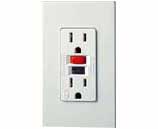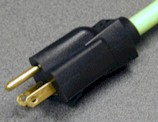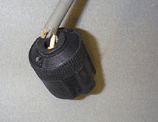|
|
Employers have the primary
responsibility for protecting the safety and health of their
workers. Employees are responsible for following the safe work
practices of their employers.
|
- Workers should know:
- Emergency procedures and policies
for their workplace.
- How to shut off the current in case of an
emergency.
- How to perform CPR.
- To pull the plug, not the cord when unplugging equipment.
|

Receptacle type (GFCI) |
- To keep power cords clear of equipment during use.
- To use ceiling plugs rather than
draping cords across aisles.
- Not to touch a worker being
shocked until the power has been turned off.
- Not to use faulty equipment or damaged receptacles and connectors.
- Not to plug in electrical equipment while touching a wet or damp surface.
- Not to use cords that are worn or damaged or cords that feel warm during
use; they have the potential to start a fire. Use a higher capacity cord or a multi-outlet power strip unit with a built-in circuit breaker instead of an extension cord.
Do not use equipment cords that feel warm during use have
them checked by an electrician.
- To report unsafe equipment and work
practices to your employer immediately.
|
|
|
Employers have the primary
responsibility for protecting the safety and health of their
workers. Employees are responsible for following the safe work
practices of their employers.
|
Follow OSHA Standards including:
- Ensure that all electrical service near sources of water is properly grounded [1910.304(f)(5)(v)].
|

Grounded cord
|
- Ensure that electrical equipment is free from recognized hazards [1910.303(b)(1)].
- Repair all damaged receptacles and portable electrical equipment before placing them back into service [1910.334(a)(2)(ii)].
|

Damage cord
|
Consider implementing recommended safe work practices, including:
|
The National Institute for Occupational
Safety and Health (NIOSH)
recommendations:
- Use ground fault circuit interrupters (GFCIs) in situations
where electricity and wetness coexist. GFCIs will interrupt the
electrical circuit before current sufficient to cause death or
serious injury has passed through a body.
- Exposed receptacle boxes be made of nonconductive material
so that contact with the box will not constitute a "ground."
- Plugs and receptacles be designed to prevent energization until insertion is complete.
|

